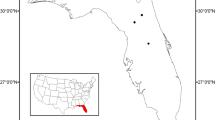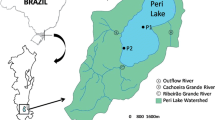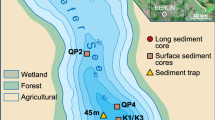Abstract
Elemental and isotopic compositions of organic matter in surficial sediments from five transects across Lagoa do Caçó (Brazil) were analyzed to identify the depth-related processes that affect the production and deposition of sedimentary organic matter in this shallow tropical lake. Each of four transverse transects began at a margin dominated by aquatic macrophytes (Eleocharis), crossed the central deep part of the lake, and terminated in the opposite, macrophyte-dominated margin. In each transect, TOC concentrations, C/N ratios, and δ13C values decreased between 0 and 4 m, whereas δ15N values increased. The variables remained stable in sediment from 4 m water depth to the center of the lake at 10 m. The depth-related patterns reflect differences in both the delivery and the deposition of organic matter in the lake. Organic matter is produced in abundance in the marginal area by emersed and submerged macrophyte vegetation that diminishes with depth and disappears at 4 meters. After the disappearance of macrophytes, organic matter is produced at low rates principally by open-lake phytoplankton. Drawdown of dissolved oxygen is high in the lake margins, but it is low in the oligotrophic open waters of the lake. Preservation of organic matter is consequently better in sediments of the lake margins than in deep waters. The depth-related pattern of organic matter delivery and deposition in the sediments of Lagoa do Caçó, in which water levels are sensitive to groundwater fluctuations, shows that the elemental and isotopic compositions of sediment organic matter can provide a record of changes in the paleohydrology of this and other similar shallow lake systems.






Similar content being viewed by others
References
Boon PI, Bunn SE (1994) Variations in the stable isotope composition of aquatic plants and their implications for food web analysis. Aquat Bot 48:99–108
Brenner M, Whitmore TJ, Curtis JH, Hodell DA, Schelske CL (1999) Stable isotope (δ13C and δ15N) signatures of sedimented organic matter as indicators of historic lake trophic state. J Paleolimnol 22:205–221
Cardoso AGA (2004) Reconstrução paleoambiental na Lagoa do Caço (Maranhão–Brasil) durante os ultimos 21.000 anos A.P. por marcadores e processos inorgânicos sedimentares. PhD dissertation, Department of Geochemistry, Fluminense Federal University, 127 pp, unpublished PhD dissertation
Dellamano-Oliveira MJ, Senna PAC, Taniguchi GM (2003) Limnological characteristics and seasonal changes in density and diversity of the phytoplanktonic community at the Caçó Pond, Maranhão State, Brazil. Braz Arch Biol Tech 46:641–651
Fellerhoff C, Voss M, Wantzen KM (2003) Stable carbon and nitrogen isotope signatures of decomposing tropical macrophytes. Aquat Ecol 37:361–375
Hassan KM, Swinehart JB, Spalding RF (1997) Evidence for holocene environmental change from C/N ratios and δ13C and δ15N values in Swan Lake sediments, western Sand Hills, Nebraska. J Paleolimnol 18:121–130
Jacob J, Disnar J-R, Boussafir M, Ledru M-P, Albuquerque ALS, Sifeddine A, Turcq B (2004a) Onocerane attests to dry climatic events during the quaternary in the tropics. Org Geochem 35:289–297
Jacob J, Disnar J-R, Boussafir M, Ledru M-P, Sifeddine A, Turcq B, Albuquerque ALS (2004b) Major environmental changes recorded by lacustrine sedimentary organic matter since the last glacial maximum near the equator (Lagoa do Caçó, NE Brazil). Palaeogeogr Palaeoclimatol Palaeoecol 205:183–197
Jacob J, Disnar J-R, Boussafir M, Ledru M-P, Albuquerque ALS, Sifeddine A, Turcq B (2007a) Contrasted distributions of triterpenes derivatives in the sediments of Lake Caçó reflect paleoenvironmental changes during the last 20, 000 yrs in NE Brazil. Org Geochem 38:180–197
Jacob J, Huang Y, Disnar J-R, Sifeddine A, Boussafir M, Albuquerque ALS, Turcq B (2007b) Paleohydrological changes during the last deglaciation in Northern Brazil. Quat Sci Rev 26:1004–1015
Jolliffe IT (2002) Principal component analysis, 2nd edn. Springer, NY
Kaushal S, Binford MW (1999) Relationship between C: N ratios of lake sediments, organic matter sources, and historical deforestation of Lake Pleasant, Massachusetts, USA. J Paleolimnol 22:439–442
Krishnamurthy RV, Bhattacharya SK, Kusumgar S (1986) Palaeoclimatic changes deduced from 13C/12C and C/N ratios of Karewa lake sediments. Nature 323:150–152
Ledru M-P, Cordeiro RC, Dominguez JML, Martin L, Mourguiart P, Sifeddine A, Turcq B (2001) Late-glacial cooling in Amazonia inferred from pollen at Lagoa do Caçó, northern Brazil. Quat Res 55:47–56
Ledru M-P, Mourguiart P, Ceccantini G, Turcq B, Sifeddine A (2002) Tropical climates in the game of two hemispheres revealed by abrupt climate change. Geology 30:275–278
Ledru M-P, Ceccantini G, Gouveia SEM, Lopez-Sáez JA, Pessenda LCR, Ribeiro AS (2006) Millennial-scale climate and vegetation changes in a northern Cerrado (Northeast Brazil) since the Last Glacial Maximum. Quat Sc Rev 25:1110–1126
Meyers PA (1994) Preservation of elemental and isotopic source identification of sedimentary organic matter. Chem Geol 114:289–302
Meyers PA, Teranes JL (2001) Sediment organic matter. In: Last WM, Smol JP (eds) Tracking environmental changes using lake sediments—volume II: physical and chemical techniques. Kluwer, Dordrecht, pp 239–269
Nascimento LR, Sifeddine A, Torgan LC, Albuquerque ALS (2010) Diatom assemblage in a tropical lake of northeastern Brazil. Braz Arch Biol Tech 53:241–248
Routh J, Choudhary P, Meyers PA, Kumar B (2009) A sediment record of recent nutrient loading and trophic state change in Lake Norrviken, Sweden. J Paleolimnol 42:325–341
Sifeddine A, Albuquerque ALS, Ledru M-P, Turcq B, Knoppers BA, Martin L, Mello WZD, Passenau H, Dominquez JML, Cordeiro RC, Abrão JJ, Bittencourt ACSP (2003) A 21,000 cal years paleoclimate change in Caçó Lake, northern Brazil: evidence from sedimentary and pollen records. Palaeogeogr Palaeoclimatol Palaeoecol 189:25–34
Sifeddine A, Wirrmann D, Albuquerque ALS, Turcq B, Cordeiro RC, Gurgel MHC, Abrão JJ (2004) Bulk composition of sedimentary organic matter palaeoenvironmental reconstructions: examples from the tropical belt of South America and Africa. Palaeogeogr Palaeoclimatol Palaeoecol 214:41–53
Talbot MR, Laerdal T (2000) The late pleistocene-holocene palaeolimnology of Lake Victoria, East Africa, based upon elemental and isotopic analyses of sedimentary organic matter. J Paleolimnol 23:141–164
Talbot MR, Livingstone DA (1989) Hydrogen index and carbon isotopes of lacustrine organic matter as lake level indicators. Palaeogeogr Palaeoclimatol Palaeoecol 70:121–137
Acknowledgments
We thank T. C. Moore for his helpful comments on our statistical analyses. This study was supported by the “PALEOTRACES” International Mixed Laboratory between Institut de Recherche pour le développement, Universidade Federal Fluminense and Universidad de Antofagasta, as well as by the CLIMPAST project (CNPq-IRD), which corresponds to the international cooperation project between the Brazilian CNPq and the IRD (Processo CNPq n°: 490735/2006-1). The authors sincerely thank the ESCARSEL ANR for financial support. Finally, we deeply appreciate the constructive comments from the reviewers and editors that helped us to improve this contribution.
Author information
Authors and Affiliations
Corresponding author
Rights and permissions
About this article
Cite this article
Sifeddine, A., Meyers, P.A., Cordeiro, R.C. et al. Delivery and deposition of organic matter in surface sediments of Lagoa do Caçó (Brazil). J Paleolimnol 45, 385–396 (2011). https://doi.org/10.1007/s10933-011-9506-0
Received:
Accepted:
Published:
Issue Date:
DOI: https://doi.org/10.1007/s10933-011-9506-0




